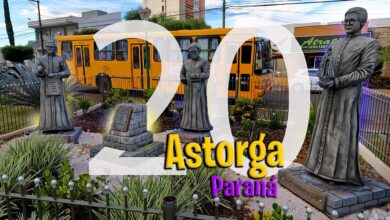
São Paulo: Freedom District 
 Japanese City in Brazil 【4k UHD】
Japanese City in Brazil 【4k UHD】
The history of Japanese immigration to Brazil is a fascinating and significant chapter in the formation of the country’s multicultural identity. In the early 20th century, Brazil, in need of labor for its coffee plantations, turned its eyes to Japan, which was facing a period of economic hardship and high population density in rural areas. On June 18, 1908, the ship Kasato Maru docked in Santos, bringing with it the first 781 Japanese immigrants, marking the official beginning of this transcontinental journey.
These pioneers, who came from various Japanese prefectures, brought with them not only the hope of a better life, but also a rich cultural background. Initially destined for coffee farms in the interior of São Paulo, they faced challenges such as an unfamiliar language, a different climate, and harsh working conditions. Despite the hardships, with perseverance and community spirit, Japanese immigrants and their descendants, known as Nikkei, gradually settled and prospered in various areas.
The flow of migrants intensified in the following decades, with waves of immigrants arriving in Brazil until the Second World War, when relations between the two countries were interrupted. After the conflict, immigration resumed, and the Japanese dispersed throughout different regions of Brazil, contributing to the development of agriculture, commerce and industry.
Today, Brazil is home to the largest Japanese diaspora outside of Japan, with an estimated two million Nikkei. São Paulo stands out as the main center of this community, concentrating a significant portion of the population of Japanese descent. The Liberdade neighborhood, in the heart of the capital of São Paulo, is the epicenter of this presence, a vibrant cultural mosaic that reflects the history and influence of Japan in Brazil.
Liberdade, with its streets adorned with oriental lanterns, its Buddhist temples and its commercial establishments with Japanese-style facades, transports visitors to a unique atmosphere. The aroma of Japanese delicacies such as sushi, sashimi, tempura and ramen wafts through the air, inviting you to an authentic gastronomic experience. The stores offer a variety of products, from handicrafts and traditional clothing to manga and electronics.
In addition to São Paulo, other Brazilian cities also have significant Japanese communities, such as Curitiba, Londrina, Maringá (in Paraná), Manaus (in Amazonas) and Tomé-Açu (in Pará). However, it is in São Paulo, and especially in the Liberdade neighborhood, that the Japanese presence is most intense and visible.
The influence of Japan and the Japanese deeply permeates Brazilian culture in many aspects. In gastronomy, Japanese cuisine has won over the palates of Brazilians, becoming one of the most appreciated and widespread in the country. Dishes such as sushi and sashimi are easily found in restaurants in all regions, and ingredients such as soy sauce, miso and ginger have become part of everyday food.
In sports, Japanese martial arts such as judo, karate, aikido and kendo have gained numerous followers in Brazil, contributing to the physical and mental discipline of their practitioners. Traditional Japanese festivals such as Bon Odori, Tanabata Matsuri and the Japan Festival are celebrated with enthusiasm in several cities, keeping traditions alive and promoting cultural exchange.
Japanese customs, such as the value placed on education, discipline, respect for elders and social harmony, have also influenced the values of Brazilian society. Japanese aesthetics, with their appreciation for nature, simplicity and elegance, can be seen in architecture, design and the visual arts.
Japanese immigration to Brazil represents a story of resilience, hard work and successful cultural integration. The largest Japanese diaspora outside Japan has found a home in Brazil, enriching the country’s diversity and leaving an indelible legacy in its culture, customs and identity. São Paulo, with its emblematic Liberdade neighborhood, is living testimony to this deep and lasting connection between Brazil and Japan.
SUPPORT THE CHANNEL, PIX: https://livepix.gg/donationsystems
SUBSCRIBE TO THE CHANNEL!
BE A MEMBER OF THE CHANNEL
https://www.youtube.com/channel/UCdgYcJTlbq3s798MPWsWxpQ/join
CHECK OUT ALL OUR VIDEOS!
https://www.youtube.com/channel/UCdgYcJTlbq3s798MPWsWxpQ/videos
#Faise #Liberdesp #FreedomsãoPaulo #São Paulo (Tagstotranslate) Brazil 4K
Best Londrina PR: Visit, subscribe, and share the Official YouTube Channel





































































 TAIWAN Vlog 9: Taichung’s Chill Food & Vintage vs. Luxury Lifestyle – Café & Brunch! Taiwan: Food & Coffee House in Taichung
TAIWAN Vlog 9: Taichung’s Chill Food & Vintage vs. Luxury Lifestyle – Café & Brunch! Taiwan: Food & Coffee House in Taichung






























